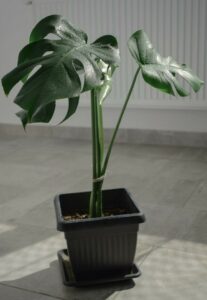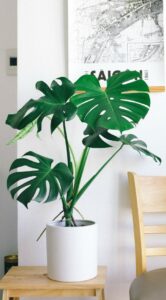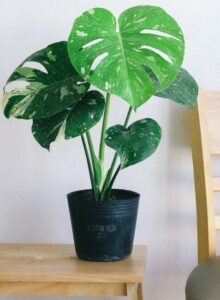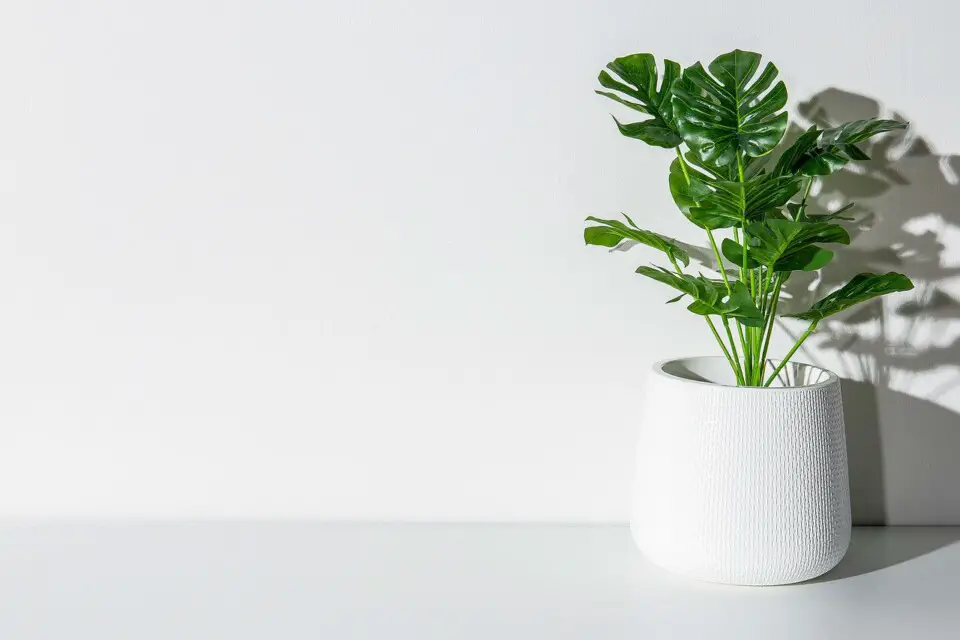Some links in the post are affiliate links and I get a commission from purchases made through some links found in the post.
Are you a monstera lover? Then this article is perfect for you. Central and South American rainforests are home to the Monstera deliciosa which has higher humidity levels than most homes.
It follows that artificial humidity levels may be necessary to maintain indoor Monsteras to look their best. You can say Monstera is a humidity lover is not wrong.
The Ideal Humidity for a Monstera
 The recommended humidity level for a Monstera is between 60 and 70 percent. Lower levels may cause parts of the leaves to turn yellow or brown and eventually fall off. The plant may begin to look wilted. Mold can grow on a plant if the humidity is too high.
The recommended humidity level for a Monstera is between 60 and 70 percent. Lower levels may cause parts of the leaves to turn yellow or brown and eventually fall off. The plant may begin to look wilted. Mold can grow on a plant if the humidity is too high.
For moist leaves, this is especially true. To keep your Monstera plant happy, you must balance humidity and temperature well.
In what way can the most accurate method of determining humidity in your home be?
To ensure that your Monstera lives happily and healthily, check your home humidity. To check out how much moisture your house has, you can use a hygrometer; you can get an absolute or a percentage reading on the humidity level.
Hygrometers that measure both humidity and temperature are readily available these days. Keeping the air around your Monstera at a comfortable temperature is essential, as this can also contribute to problems if not.
Devices that measure humidity are called hygrometers. It’s possible to buy one in a garden center or online.
Several options are available, but the most basic digital models don’t cost much and provide temperature and humidity levels.
Measures the amount of water vapor in the air using a simple sensor. Humidity rises in direct proportion to water vapor concentration.
Your senses can also inform you if the air is too dry. If you have chapped lips or dry skin, it’s a sign that the air needs to be moistened.
Six Essential Ways to Increase the Humidity in your Home
Making your house more humid is suitable for both your plants and you, the human occupants. Static electricity and chapped lips are two common side effects of living in an area with dry air.
You can improve the humidity in your house in several ways, which we’ll go over now. These ways will help you increase your home’s humidity, which is ideal for your Monstera to make it happy.
1) Plants in a Row
It is simple to generate a microclimate by grouping many plants. Your plants’ transpiration will enhance the humidity in their area if you gather them together.
As an added benefit, they prevent evaporating moisture from escaping into the atmosphere.
After grouping your plants, you can improve matters by placing a water-filled container in the middle of the group. You may even use it for outdoor Monstera plants because it helps raise humidity even more.
2) Spray your Plant with a Water
Humidity can be increased in various ways, the most frequent being misting. A spray bottle is used to mist your plant with water. Humidity rises as water evaporates.
When watering your plants, avoid using tap water because it can leave behind white deposits.
If you can, do it early in the day when the water will have had time to evaporate. To avoid fungal or bacterial illnesses, avoid keeping leaves damp for long periods.
3) Use a Pebble Tray
To build a pebble tray, fill a water tray no more than two-thirds of the way with large pebbles. After that, place the pot on rocks and watch to see that no water gets to the plant.
You may place a pebble tray under or near your plants that prefer high humidity. Add water to the top layer of pebbles in a bowl or tray, and you’re done.
Your plants will benefit from the increased humidity from the evaporating water if you set them on top of the pebbles.
Pebble trays are a great option if you’re looking to add humidity to a small space because they’re inexpensive and easy to make. Without adequate evaporation, the standing water can also become an ideal environment for mildew growth.
4) Use a Humidifier
A humidifier may be the most superb option to enhance humidity for you and your monstera plants. Something like this will come in handy when the weather gets colder. Because the air is less able to hold moisture.
Most models can run nonstop for at least a day and shut off automatically if running out of water; they also use relatively little electricity. Unless there is power, they will reliably maintain high humidity.
5) Keep the Doors Open

The bathroom door can be left open while you shower (and the bathroom fan turned off), or a kettle of water can be put on the stove to boil to raise the humidity in the house.
In terms of cost, these low-cost options have a limited impact. A humidifier is your best bet for long-term humidity increases that can be managed.
6) Avoid Placing Plants in the Wind
It will enhance the humidity around your Monstera plants as the water evaporates, but it will have little effect on the overall humidity of your house.
Avoid placing your plant in an area with a lot of wind if you want the most significant results. The moisture will be carried away by the wind.
Are There Signs that the Humidity in your Monstera is too Low?
The following are signs that your Monstera isn’t getting enough humidity:
- Leaves will be crunchy and dry, with brown tips and edges. In between the veins, you may notice brown patches as well.
- Weakening and collapsing
- You may notice that the leaves of your Monstera are turning yellow
- Leaves that curl, roll, or cup
- The growth that is slowed or stunted
- An increase in the amount of water required
- There is a chance that leaves will fall off or be blown away
- Plants with a dull appearance
Your monstera humidity may be out of balance if you notice the following symptoms.
Do Monsteras need a Humidifier?
A humidifier can be a great addition to helping increase the moisture for your monstera. In the 6-their natural habitat, tropical rainforest species grow in a climate that is both warm and humid.
Because of this, their leaves will become dull, with brown tips and edges, curled edges, and so on, when placed in a less humid environment. If you want to keep your Monstera happy, a humidifier is a great idea.
Warm and cool mist humidifiers are available. The mist is produced in various ways, each with its unique temperature and method, as you might expect.
Warm mist humidifiers perform better for my plants than cool mist humidifiers, even though they both have advantages and disadvantages.
Do Monsteras Like to Stay Moist?
Monsteras do like to stay moist! Although Monsteras don’t have many requirements, they prefer a humidity level of 50% to 80%.
A healthy Monstera deliciosa doesn’t always require more humidity, although it’s always wonderful to have it. It’s essential to keep your plant in an environment that is as moist as possible to create a beautiful Monstera.
You should mist your monstera plant to keep it happy and healthy. To keep them comfortable, misting is all that is required.
How to Mist your Monstera?
To improve the humidity levels around your plants, you need to spritz your Monstera deliciosa multiple times a day, which isn’t essential.
It’s possible that misting your pole’s aerial roots and moss once a day is more effective and takes less time.
Using a humidifier, a pebble tray, or a Mister to regularly mist the leaves will help raise the humidity level in your plant’s environment.
Your Monstera will thrive in temperatures between 60- and 80 degrees Fahrenheit. Temperatures below 55 degrees Fahrenheit or sudden temperature drops are not tolerated by it.
You may be able to prevent root rot by misting both your Monstera’s aerial roots and its moss pole, which is why misting may be preferable.
The health of your Monstera plant’s aerial roots is an important consideration, you need to ensure they’re not thirsty.
Can you Keep Monsteras in the Bathroom?
The Swiss cheese plant, Monstera deliciosa, is an excellent choice for your bathroom. This plant thrives even in low-light conditions, thanks to the added humidity in the bathroom.
Adding greenery and improved air quality provided by houseplants can enhance the experience of using the toilet. Water for spraying houseplants is readily available in the bathroom because it is typically a warm, humid room.
This plant thrives in low-light settings because of the bathroom’s extra humidity.
Your Monstera can thrive in the shade, perhaps at a slower pace and with fewer of its distinctive slits and perforations in its leaves, but it will still be healthy.
Final Thoughts
 Monstera plants are known for their capacity to thrive in various environments, although humidity can play a significant role in their care.
Monstera plants are known for their capacity to thrive in various environments, although humidity can play a significant role in their care.
Because of their large size and high nutritional requirements, these plants can grow up to 12 feet tall under the right conditions.
Monstera is one of the most tolerant plants in the world. As long as the temperature and humidity levels aren’t too high or low, they can thrive.
When it comes to living in a dry, arid area, however, things are a little more complicated. Making sure they have adequate humidity can make a significant difference.
The Monstera is native to the tropics doesn’t mean you can keep it constantly wet. Your Monstera’s foliage can become a magnet for pests and other common issues if it is always wet.
If you want your Monstera to be happy and healthy, you must follow everything discussed earlier.
Finally, I’ve learned how to properly care for my monstera plants, which is a huge accomplishment.


